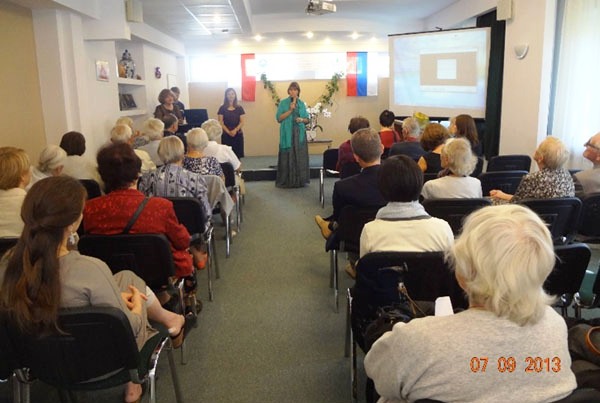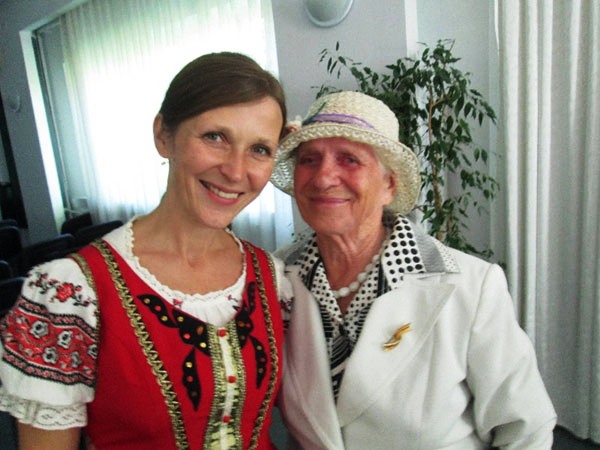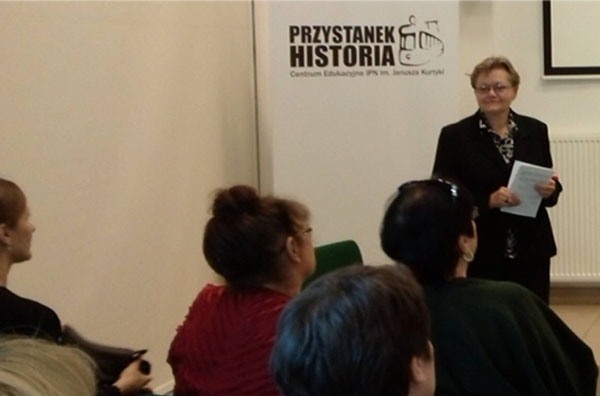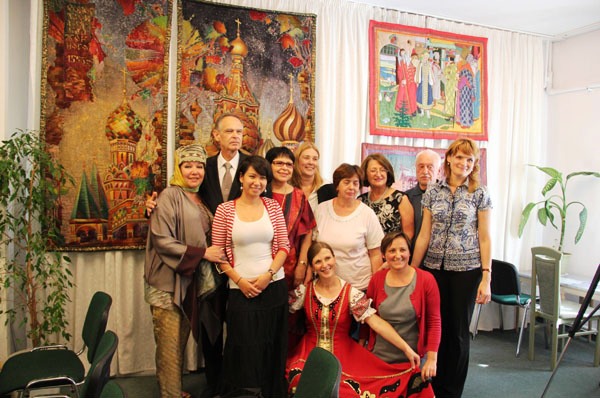![]()
The Words of the Krasnosumova Family
|
|
The Words of the Krasnosumova Family |

Warsaw, Poland -- "What is True Reconciliation? The Difficult History of Polish-Russian Relations" was the theme of a peacemaking effort made by the Polish and Russian chapters of the Women's Federation for World Peace in cooperation with the Universal Peace Federation, Eurasian region. This study tour brought 12 Russians to the Polish cities of Warsaw and Krakow, where they met and interacted with more than 40 Poles. The highlight of the event, which took place from Sept. 6 to 12, 2013, was a Bridge of Peace ceremony between citizens of the two nations.

Poland and Russia have fought numerous wars against each other. Many Poles have a long history of resentment against Russia going back to the late 1700s, when Russia was one of the three European powers that divided Poland among themselves. Poles suffered especially under the Soviet communist occupation from 1939 to 1990. A reminder of this painful history came in April 2010, when a Polish air force jet carrying the Polish president, his wife and many high-level Polish officials crashed near the Russian city of Smolensk, killing all 96 people on board. They had been traveling to Russia for a ceremony honoring the victims of the Katyn Forest massacre, in which the Soviet secret police executed 22,000 Polish nationals in the spring of 1940.

The study tour and the Bridge of Peace ceremony were organized by the Russian and Polish WFWP chapters in order to let the participants from each nation understand the other nation's suffering and to bring about forgiveness and reconciliation. So that the Russian guests could learn about historical events involving Russia and the Soviet Union, they were brought to the Warsaw Uprising Museum, the Educational Center of the Institute of National Remembrance, and the House for Meetings with History; they also were shown historical Polish-Russian sites in Warsaw and Krakow. They watched the film "Katyn," directed by the famed Polish director Andrzej Wajda, and the documentary "I Saw the Executioner," directed by Natalya Lobko.
So that the Polish participants would understand Russia better, they were invited to the program "Close and Faraway Cultures: Russia, Its Spirituality, Customs, Traditions," which was held at the Peace Embassy in Warsaw. This program was followed by a Bridge of Peace ceremony in which 50 participants took part.
Two important meetings took place during the study tour. The first, at the Helsinki Foundation for Human Rights in Warsaw, allowed both sides to present their view of Russian-Polish history. The second was a meeting with a representative of the Katyn Families Federation, a historian who shared both her family's personal experiences and historical facts related to the Katyn massacre.
Two very open and interesting discussions are worth mentioning. The first, with a historian from the KARTA Center, focused on the Katyn massacre, and the second, with a historian from the Institute of National Remembrance, focused on the Soviet occupation of Poland in 1939 and events after 1945.
Three times during the study tour Russian participants, from the bottom of their hearts, asked Polish participants for forgiveness. The Polish participants were deeply moved by the Russians' sincerity. Some Poles said later that they admired the courage of the Russians who were willing to face difficult historical truths related to Polish-Russian relations and could speak openly about the difficult history of their own country.
The organizers hope that this study tour will be the first of a series of programs that will bring the two nations closer. Ideas for future projects, proposed during the study tour, include an interactive history education project for schools and Bridge of Peace ceremonies for the younger generation.
For more information (in Polish) please visit: federacjakobiet.blogspot.com

Among the Russian speakers at the Sept. 7 program "Close and Faraway Cultures: Russia, Its Spirituality, Customs, Traditions" were Olga Vakulinskaya, president of the Women's Federation for World Peace, Eurasian region; painter, designer and writer Elena Pelevina; and producer and director Valentina Vladislavleva. Their presentations about the values and culture of Russia were both lively and moving.
Representing the Polish side, Anna Brzyska, Ph.D., and Alexandra Skoneczna, chairwoman of WFWP of Poland, spoke about the Russian church buildings of the 15th to 17th centuries and the spiritual paintings of Russian artist Nicholas Roerich.
Krzysztof Gago, secretary general of the Universal Peace Federation of Poland, spoke about creating harmony between Poland and Russia. In order to do this, he said, their peoples must not cultivate resentment but rather should forgive each other and establish relationships based on common values.
In response to his speech, Russian participants, standing before their Polish friends, asked for forgiveness on behalf of their country for all the wrongs done by the Soviet communist military to the Polish people. The ceremony ended with a half-bow.
The most moving and memorable moment of the day was the Bridge of Peace ceremony in which Polish men and women gained Russian brothers or sisters for future close relations. The newly created pairs exchanged addresses and telephone numbers.
After lunch the conference participants toured Warsaw, visiting sites connected with Polish-Russian history.
The second day, Sept. 8, started with a visit to the Museum of the Warsaw Uprising (1944), during which we could see the tragic events of that time. The museum was located in one of the few buildings that remained whole after the war, a former streetcar depot. One room of the exhibition presented before-and-after photos of buildings that had been bombed. Another room represented a fragment of an underground tunnel through which civilians during the time of German occupation passed from the occupied areas to the safer zones of Warsaw. They had to move in complete silence, because the Germans had installed listening devices. Upon hearing the slightest noise at the bottom, the Germans injected gas, flooded the underground passages with water or threw grenades. They had orders to leave not even a single Pole alive!
After visiting the exhibition we viewed a documentary film about the Katyn massacre entitled "I Saw the Executioner," directed by Natalya Lobko. We left the museum with tears in our eyes and a heavy sense of guilt and remorse. In the afternoon we laid flowers at the cemetery of Soviet army soldiers who died in 1944 and 1945.
The third day, Sept. 9, started in the conference hall of the Helsinki Foundation for Human Rights. Danuta Przywara, chair of the foundation, shared her thoughts about the meaning of reconciliation for each of us. Olga Vakulinskaya, president of the Eurasian branch of the Women's Federation, outlined a female view on Polish-Russian relations. Journalist and editor Richard Karpovich spoke on Polish-Russian relations of yesterday and today. After a break, Alexandra Skoneczna, chairwoman of WFWP of Poland, presented a talk entitled "Is True Reconciliation Possible to Achieve? The World Tradition of Bridges of Peace."
Tatiana Krasnosumova, secretary-general of UPF in northwest Russia, spoke on "Overcoming Barriers" and called on all peoples of the Baltic region to support the concept of "peace in the soul -- love in the family -- peace on the planet." This concept is meant to reduce tension between the peoples of Russia and the other Baltic nations through social dialogue based on common values. The speaker emphasized the importance of creating an International Youth Peace Council, because the future of our countries depends on the efforts of the youth.
On Sept. 10, the participants visited the Institute of National Remembrance, the educational center named in honor of historian Janusz Kurtyka. There we met one of the few survivors of Katyn, who shared her memories. Afterward we watched the movie "Katyn," which had been directed by Andrzej Wajda. The impression in our hearts was one of grief and compassion for those who had perished in the Katyn massacre.
That evening we went by train to Krakow, where we were welcomed by our Polish friends. At a wonderful dinner the hosts explained about the religious traditions of the Polish people. An improvised concert followed, with Polish and Russian performers. The next day we were given a tour of Krakow, and then we returned to Warsaw by a night train, before flying home to St. Petersburg on Sept. 12.
The members of the St. Petersburg group agreed that the trip had been very informative and useful. Not only did we receive much new information for reflection but we also made many new friends!